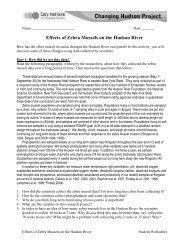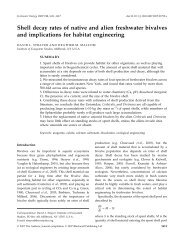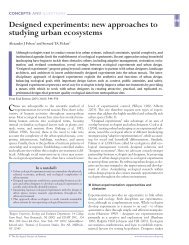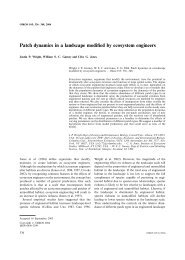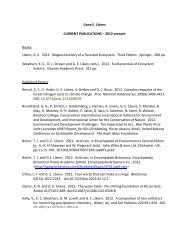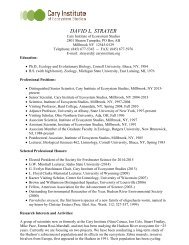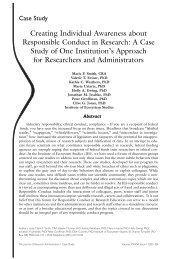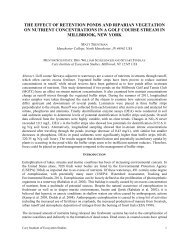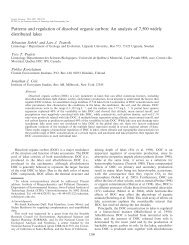Matthew C. Van de Bogert, Stephen R. Carpenter, Jonathan J. Cole ...
Matthew C. Van de Bogert, Stephen R. Carpenter, Jonathan J. Cole ...
Matthew C. Van de Bogert, Stephen R. Carpenter, Jonathan J. Cole ...
You also want an ePaper? Increase the reach of your titles
YUMPU automatically turns print PDFs into web optimized ePapers that Google loves.
<strong>Van</strong> <strong>de</strong> <strong>Bogert</strong> et al.Benthic and pelagic metabolismTable 1. Definition of symbols used in the mo<strong>de</strong>ls.Symbol Definition Unitsa shape parameter (vertical stretch) for the dimensionlessinverse tangent functionA Bratio of benthic area to lake surface area dimensionlessb shape parameter (horizontal shift) for the dimensionlessinverse tangent functionD instantaneous rate of diffusion between mmol m –3 d –1lake and atmosphereGPP instantaneous rate of gross primary mmol m –3 d –1productionGPP24 daily rate of gross primary production mmol m –3 d –1GPP bdaily rate of benthic gross primary mmol m –2 d –1productionGPP pdaily rate of planktonic gross primary mmol m –3 d –1productionk coefficient of gas exchange m d –1k 600coefficient of gas exchange for a gas with m d –1a Schmidt number of 600m xproportion of metabolism (GPP or R) from dimensionlessbenthic sources sensed by a son<strong>de</strong>placed at distance x from shorePAR photosynthetically active radiation on the μmol m –2 Δt –1lake surface over a 5-min intervalPAR24 daily photosynthetically active radiation μmol m –2 d –1on the lake surfaceR instantaneous rate of whole ecosystem mmol m –3 d –1respirationR24 daily rate of whole ecosystem respiration mmol m –3 d –1R bdaily rate of benthic respiration mmol m –2 d –1R pdaily rate of planktonic respiration mmos m –3 d –1t time dY dissolved oxygen concentration μMz x<strong>de</strong>pth of water in the epilimnion at mlocation xZ autocorrelated mo<strong>de</strong>l error μMΔt small interval dε mo<strong>de</strong>l error corrected for autocorrelation μMϕ autocorrelation coefficient dimensionlessconstant value for k 600of 0.4 m d –1 , which is within the rangeof estimates based on wind, CH 4flux measurements, and anSF 6addition to this lake (Ba<strong>de</strong> and <strong>Cole</strong> 2006). Finally, theareal diffusive flux is divi<strong>de</strong>d by the epilimnion <strong>de</strong>pth, z, toexpress the value in volumetric units.The prediction error Z tis autocorrelated, and an autocorrelationcorrection is computed asZ= ϕZ+ εt t−1tTo estimate the parameters GPP24 and R24, we minimizedthe normal negative log likelihood of the Z t(Hilborn andMangel 1997). To <strong>de</strong>termine the autocorrelation coefficient, ϕ,we then minimized the normal negative log likelihood of the ε t.(6)Table 2. Steps in bootstrappingStepDescription1) Fit mo<strong>de</strong>l Y = f( X, θ)+ ε Determine nominal set of parameters, θ,by minimizing the normal negativelog likelihood of the ε. Computepredictions as Yˆ = f( X, θ).Save Ŷ , θ, and ε.2) Bootstrapping loop2a) Compute pseudo- Randomly sample, with replacement, theobservationsε as ε R. Create pseudo-observationsas Y = Y ˆ + ε .PR2b) Refit mo<strong>de</strong>l Find new set of parameters, θ B, byminimizing the normal negative loglikelihood of the ε R. Save bootstrapestimates, θ B.2c) Repeat Return to 2a and repeat 10,000 times.3) Compute Statistics Find mean, standard <strong>de</strong>viation, confi<strong>de</strong>nceintervals, covariance matrix, and soon, for bootstrap estimates of theparameters, θ B.Minimization was computed using the fminsearch function ofMatlab (v. 7). We computed 95% confi<strong>de</strong>nce intervals of theparameters by bootstrapping with 10,000 iterations (Efron andTibshirani 1993). Estimates of GPP24 and R24 were computedfor each 24-h period beginning at sunrise as calculated fromthe latitu<strong>de</strong> of Peter Lake and the <strong>de</strong>clination of the sun oneach day (Hartmann 1994).Site-specific estimates of metabolism obtained by fittingequations 3 and 6 to the data make no assumptions aboutsource (benthic or pelagic) of the metabolic fluxes. The estimatesof GPP24 or R24 represent the sum of the processesaffecting the concentration of oxygen at that locationregardless of whether they are benthic or pelagic. We usedthese site-specific estimates in two ways. First, on all days, wecalculated spatially explicit volume-weighted estimates ofwhole-lake GPP and R and compared these to estimates ma<strong>de</strong>by a single sensor at the middle of the lake. Second, weapplied, when possible, a mo<strong>de</strong>l of whole-lake metabolism tocalculate the separate contributions of benthic and pelagicprocesses to GPP and R.Spatially explicit volume-weighted estimate of whole lakemetabolism—For each of the 40 dates on which we measuredfree-water metabolism, we applied the measured rates fromeach transect location to the volume of the epilimnion representedby that location. We first calculated the surface area ofconcentric rings divi<strong>de</strong>d at the midpoints between each son<strong>de</strong>site and then calculated the volume of water within each concentricring based on the hypsographic curve for the lake.Metabolic rates for each ring were multiplied by the appropriatevolume of water and summed for the entire epilimnion.Estimating rates of benthic and pelagic metabolism—Wheremetabolism changes monotonically from inshore to the center148



